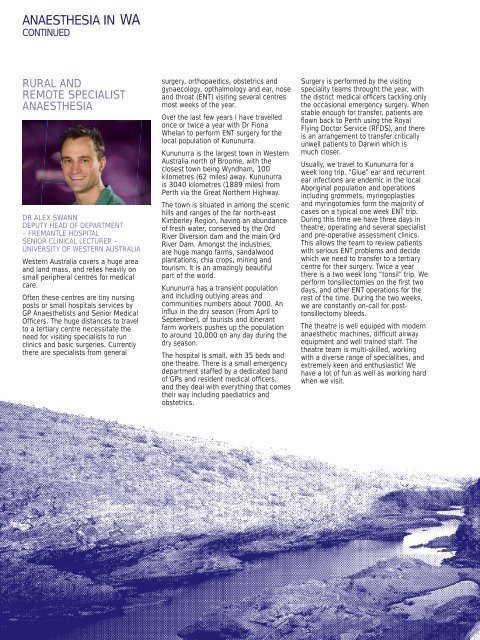ANZCA Bulletin June 2011 - Australian and New Zealand College of ...
ANZCA Bulletin June 2011 - Australian and New Zealand College of ...
ANZCA Bulletin June 2011 - Australian and New Zealand College of ...
Create successful ePaper yourself
Turn your PDF publications into a flip-book with our unique Google optimized e-Paper software.
ANAESTHESIA IN WA<br />
CONTINUED<br />
RURAL AND<br />
REMOTE SPECIALIST<br />
ANAESTHESIA<br />
DR ALEX SWANN<br />
DEPUTY HEAD OF DEPARTMENT<br />
– FREMANTLE HOSPITAL<br />
SENIOR CLINICAL LECTURER –<br />
UNIVERSITY OF WESTERN AUSTRALIA<br />
Western Australia covers a huge area<br />
<strong>and</strong> l<strong>and</strong> mass, <strong>and</strong> relies heavily on<br />
small peripheral centres for medical<br />
care.<br />
Often these centres are tiny nursing<br />
posts or small hospitals services by<br />
GP Anaesthetists <strong>and</strong> Senior Medical<br />
Offi cers. The huge distances to travel<br />
to a tertiary centre necessitate the<br />
need for visiting specialists to run<br />
clinics <strong>and</strong> basic surgeries. Currently<br />
there are specialists from general<br />
surgery, orthopaedics, obstetrics <strong>and</strong><br />
gynaecology, opthalmology <strong>and</strong> ear, nose<br />
<strong>and</strong> throat (ENT) visiting several centres<br />
most weeks <strong>of</strong> the year.<br />
Over the last few years I have travelled<br />
once or twice a year with Dr Fiona<br />
Whelan to perform ENT surgery for the<br />
local population <strong>of</strong> Kununurra.<br />
Kununurra is the largest town in Western<br />
Australia north <strong>of</strong> Broome, with the<br />
closest town being Wyndham, 100<br />
kilometres (62 miles) away. Kununurra<br />
is 3040 kilometres (1889 miles) from<br />
Perth via the Great Northern Highway.<br />
The town is situated in among the scenic<br />
hills <strong>and</strong> ranges <strong>of</strong> the far north-east<br />
Kimberley Region, having an abundance<br />
<strong>of</strong> fresh water, conserved by the Ord<br />
River Diversion dam <strong>and</strong> the main Ord<br />
River Dam. Amongst the industries,<br />
are huge mango farms, s<strong>and</strong>alwood<br />
plantations, chia crops, mining <strong>and</strong><br />
tourism. It is an amazingly beautiful<br />
part <strong>of</strong> the world.<br />
Kununurra has a transient population<br />
<strong>and</strong> including outlying areas <strong>and</strong><br />
communities numbers about 7000. An<br />
infl ux in the dry season (From April to<br />
September), <strong>of</strong> tourists <strong>and</strong> itinerant<br />
farm workers pushes up the population<br />
to around 10,000 on any day during the<br />
dry season.<br />
The hospital is small, with 35 beds <strong>and</strong><br />
one theatre. There is a small emergency<br />
department staffed by a dedicated b<strong>and</strong><br />
<strong>of</strong> GPs <strong>and</strong> resident medical <strong>of</strong>fi cers,<br />
<strong>and</strong> they deal with everything that comes<br />
their way including paediatrics <strong>and</strong><br />
obstetrics.<br />
Surgery is performed by the visiting<br />
speciality teams throught the year, with<br />
the district medical <strong>of</strong>fi cers tackling only<br />
the occasional emergency surgery. When<br />
stable enough for transfer, patients are<br />
fl own back to Perth using the Royal<br />
Flying Doctor Service (RFDS), <strong>and</strong> there<br />
is an arrangement to transfer critically<br />
unwell patients to Darwin which is<br />
much closer.<br />
Usually, we travel to Kununurra for a<br />
week long trip. “Glue” ear <strong>and</strong> recurrent<br />
ear infections are endemic in the local<br />
Aboriginal population <strong>and</strong> operations<br />
including grommets, myringoplasties<br />
<strong>and</strong> myringotomies form the majority <strong>of</strong><br />
cases on a typical one week ENT trip.<br />
During this time we have three days in<br />
theatre, operating <strong>and</strong> several specialist<br />
<strong>and</strong> pre-operative assessment clinics.<br />
This allows the team to review patients<br />
with serious ENT problems <strong>and</strong> decide<br />
which we need to transfer to a tertiary<br />
centre for their surgery. Twice a year<br />
there is a two week long “tonsil” trip. We<br />
perform tonsillectomies on the fi rst two<br />
days, <strong>and</strong> other ENT operations for the<br />
rest <strong>of</strong> the time. During the two weeks,<br />
we are constantly on-call for posttonsillectomy<br />
bleeds.<br />
The theatre is well equiped with modern<br />
anaesthetic machines, diffi cult airway<br />
equipment <strong>and</strong> well trained staff. The<br />
theatre team is multi-skilled, working<br />
with a diverse range <strong>of</strong> specialities, <strong>and</strong><br />
extremely keen <strong>and</strong> enthusiastic! We<br />
have a lot <strong>of</strong> fun as well as working hard<br />
when we visit.<br />
30<br />
<strong>ANZCA</strong> <strong>Bulletin</strong> <strong>June</strong> <strong>2011</strong>

















